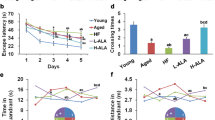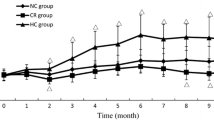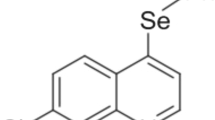Abstract
Cholesterol plays an important role in synaptic plasticity, learning and memory. To better explore how dietary cholesterol contributes to learning and memory and the related changes in synaptic structural plasticity, rats were categorized into a regular diet (RD) group and a cholesterol-enriched diet (CD) group, and were fed with respective diet for 2 months. Dietary cholesterol impacts on learning and memory, hippocampal synaptic ultrastructure, expression levels of postsynaptic density-95 (PSD-95), synaptophysin (SYP) and cannabinoid receptor type 1 (CB1R) were investigated. We found CD rats had better performances in learning and memory using Morris water maze and object recognition test than RD rats. The memory improvement was accompanied with alterations of synaptic ultrastructure in the CA1 area of the hippocampus evaluated by electron microscopy, enhanced immunoreactivity of SYP, a presynaptic marker in hippocampus detected by immunocytochemistry, as well as increased levels of PSD-95, SYP and decreased level of CB1R in brains of CD rats determined by Western blot. Taken together, the results suggest that the improvement of learning and memory abilities of the young adult rats induced by dietary cholesterol may be linked with changes in synaptic structural plasticity in the brain.





Similar content being viewed by others
References
Guo J, Chi S, Xu H, Jin G, Qi Z (2008) Effects of cholesterol levels on the excitability of rat hippocampal neurons. Mol Membr Biol 25:216–223
Frank C, Rufini S, Tancredi V, Forcina R, Grossi D, D’Arcangelo G (2008) Cholesterol depletion inhibits synaptic transmission and synaptic plasticity in rat hippocampus. Exp Neurol 212:407–414
Freeman LR, Granholm A-CE (2012) Vascular changes in rat hippocampus following a high saturated fat and cholesterol diet. J Cereb Blood Flow Metab 32:643–653
Vliet PV (2012) Cholesterol and late-life cognitive decline. J Alzheimers Dis 30(Suppl 2):147–162
Ehrlich D, Pirchl M, Humpel C (2012) Effects of long-term moderate ethanol and cholesterol on cognition, cholinergic neurons, inflammation, and vascular impairment in rats. Neuroscience 205:154–166
Umeda T, Tomiyama T, Kitajima E, Idomoto T, Nomura S, Lambert MP, Klein WL, Mori H (2012) Hypercholesterolemia accelerates intraneuronal accumulation of Abeta oligomers resulting in memory impairment in Alzheimer’s disease model mice. Life Sci 91:1169–1176
Thirumangalakudi L, Prakasam A, Zhang R, Bimonte-Nelson H, Sambamurti K, Kindy MS, Bhat NR (2008) High cholesterol-induced neuroinflammation and amyloid precursor protein processing correlate with loss of working memory in mice. J Neurochem 106:475–485
Li L, Cao D, Kim H, Lester R, Fukuchi K-I (2006) Simvastatin enhances learning and memory independent of amyloid load in mice. Ann Neurol 60:729–739
Dufour F, Liu Q-Y, Gusev P, Alkon D, Atzori M (2006) Cholesterol-enriched diet affects spatial learning and synaptic function in hippocampal synapses. Brain Res 1103:88–98
Miller S, Wehner JM (1994) Cholesterol treatment facilitates spatial learning performance in DBA/2Ibg mice. Pharmacol Biochem Behav 49:257–261
Upchurch M, Wehner JM (1988) DBA/2Ibg mice are incapable of cholinergically-based learning in the Morris water task. Pharmacol Biochem Behav 29:325–329
Schreurs BG, Smith-Bell CA, Lochhead J, Sparks DL (2003) Cholesterol modifies classical conditioning of the rabbit (Oryctolagus cuniculus) nictitating membrane response. Behav Neurosci 117:1220–1232
Micale V, Scapagnini G, Colombrita C, Mazzola C, Alkon DL, Drago F (2008) Behavioral effects of dietary cholesterol in rats tested in experimental models of mild stress and cognition tasks. Eur Neuropsychopharmacol 18:462–471
Darwish DS, Wang D, Konat GW, Schreurs BG (2010) Dietary cholesterol impairs memory and memory increases brain cholesterol and sulfatide levels. Behav Neurosci 124:115–123
Kaplan JR, Shively CA, Fontenot MB, Morgan TM, Howell SM, Manuck SB, Muldoon MF, Mann JJ (1994) Demonstration of an association among dietary cholesterol, central serotonergic activity, and social behavior in monkeys. Psychosom Med 56:479–484
Faulks SC, Turner N, Else PL, Hulbert AJ (2006) Calorie restriction in mice: effects on body composition, daily activity, metabolic rate, mitochondrial reactive oxygen species production, and membrane fatty acid composition. J Gerontol A Biol Sci Med Sci 61:781–794
Matsuo N, Reijmers L, Mayford M (2008) Spine-type-specific recruitment of newly synthesized AMPA receptors with learning, vol 319. American Association for the Advancement of Science, Washington, DC
Xu T, Yu X, Perlik AJ, Tobin WF, Zweig JA, Tennant K, Jones T, Zuo Y (2009) Rapid formation and selective stabilization of synapses for enduring motor memories. Nature 462:915–919
Yang G, Pan F, Gan W-B (2009) Stably maintained dendritic spines are associated with lifelong memories. Nature 462:920–924
Radwanska K, Medvedev NI, Pereira GS, Engmann O, Thiede N, Moraes MF, Villers A, Irvine EE, Maunganidze NS, Pyza EM, Ris L, Szymanska M, Lipinski M, Kaczmarek L, Stewart MG, Giese KP (2011) Mechanism for long-term memory formation when synaptic strengthening is impaired. Proc Natl Acad Sci USA 108:18471–18475
Bourne JN, Harris KM (2011) Coordination of size and number of excitatory and inhibitory synapses results in a balanced structural plasticity along mature hippocampal CA1 dendrites during LTP. Hippocampus 21:354–373
Babic M, Zinsmaier KE (2011) Memory, synapse stability, and β-adducin. Neuron 69:1039–1041
Holtmaat A, Svoboda K (2009) Experience-dependent structural synaptic plasticity in the mammalian brain. Nat Rev Neurosci 10:647–658
Hayakawa K, Mishima K, Nozako M, Hazekawa M, Aoyama Y, Ogata A, Harada K, Fujioka M, Abe K, Egashira N, Iwasaki K, Fujiwara M (2007) High-cholesterol feeding aggravates cerebral infarction via decreasing the CB1 receptor. Neurosci Lett 414:183–187
Tagliaferro P, Javier Ramos A, Onaivi ES, Evrard SG, Lujilde J, Brusco A (2006) Neuronal cytoskeleton and synaptic densities are altered after a chronic treatment with the cannabinoid receptor agonist WIN 55,212-2. Brain Res 1085:163–176
Carr TP, Jesch ED, Brown AW (2008) Endocannabinoids, metabolic regulation, and the role of diet. Nutr Res 28:641–650
Timofeeva E, Baraboi ED, Poulin AM, Richard D (2009) Palatable high-energy diet decreases the expression of cannabinoid type 1 receptor messenger rna in specific brain regions in the rat. J Neuroendocrinol 21:982–992
Simons K, Toomre D (2000) Lipid rafts and signal transduction. Nat Rev Mol Cell Biol 1:31–39
Morris R (1984) Developments of a water-maze procedure for studying spatial learning in the rat. J Neurosci Methods 11:47–60
de Lima MN, Laranja DC, Bromberg E, Roesler R, Schroder N (2005) Pre- or post-training administration of the NMDA receptor blocker MK-801 impairs object recognition memory in rats. Behav Brain Res 156:139–143
Blalock EM, Chen K-C, Sharrow K, Herman JP, Porter NM, Foster TC, Landfield PW (2003) Gene microarrays in hippocampal aging: statistical profiling identifies novel processes correlated with cognitive impairment. J Neurosci 23:3807–3819
Paxinos G (2004) The rat brain in stereotaxic coordinates/George Paxinos, Charles Watson. Elsevier Academic, London
Hou Y, Zhou L, Yang QD, Du XP, Li M, Yuan M, Zhou ZW (2012) Changes in hippocampal synapses and learning-memory abilities in a streptozotocin-treated rat model and intervention by using fasudil hydrochloride. Neuroscience 200:120–129
Ya BL, Li CY, Zhang L, Wang W, Li L (2010) Cornel iridoid glycoside inhibits inflammation and apoptosis in brains of rats with focal cerebral ischemia. Neurochem Res 35:773–781
Mailman T, Hariharan M, Karten B (2011) Inhibition of neuronal cholesterol biosynthesis with lovastatin leads to impaired synaptic vesicle release even in the presence of lipoproteins or geranylgeraniol. J Neurochem 119:1002–1015
Maura H, Steve M, Dieter T, Ulf D, John W, Ingemar B (2005) Crossing the barrier: net flux of 27-hydroxycholesterol into the human brain, vol 46. American Society for Biochemistry and Molecular Biology, Bethesda
Ghribi O, Larsen B, Schrag M, Herman MM (2006) High cholesterol content in neurons increases BACE, beta-amyloid, and phosphorylated tau levels in rabbit hippocampus. Exp Neurol 200:460–467
Stupien G, Florian C, Roullet P (2003) Involvement of the hippocampal CA3-region in acquisition and in memory consolidation of spatial but not in object information in mice. Neurobiol Learn Mem 80:32–41
Restivo L, Vetere G, Bontempi B, Ammassari-Teule M (2009) The formation of recent and remote memory is associated with time-dependent formation of dendritic spines in the hippocampus and anterior cingulate cortex. J Neurosci 29:8206–8214
Shema R, Sacktor TC, Dudai Y (2007) Rapid erasure of long-term memory associations in the cortex by an inhibitor of PKM zeta. Science 317:951–953
Harms KJ, Dunaevsky A (2007) Dendritic spine plasticity: looking beyond development. Brain Res 1184:65–71
Hu R, Cai WQ, Wu XG, Yang Z (2007) Astrocyte-derived estrogen enhances synapse formation and synaptic transmission between cultured neonatal rat cortical neurons. Neuroscience 144:1229–1240
Kwon SE, Chapman ER (2011) Synaptophysin regulates the kinetics of synaptic vesicle endocytosis in central neurons. Neuron 70:847–854
Cheng XR, Yang Y, Zhou WX, Zhang YX (2011) Expression of VGLUTs contributes to degeneration and acquisition of learning and memory. Neurobiol Learn Mem 95:361–375
Rehm H, Wiedenmann B, Betz H (1986) Molecular characterization of synaptophysin, a major calcium-binding protein of the synaptic vesicle membrane. EMBO J 5:535–541
Mullany PM, Lynch MA (1998) Evidence for a role for synaptophysin in expression of long-term potentiation in rat dentate gyrus. NeuroReport 9:2489–2494
Chen X, Nelson CD, Li X, Winters CA, Azzam R, Sousa AA, Leapman RD, Gainer H, Sheng M, Reese TS (2011) PSD-95 is required to sustain the molecular organization of the postsynaptic density. J Neurosci 31:6329–6338
Fisar Z (2009) Phytocannabinoids and endocannabinoids. Curr Drug Abuse Rev 2:51–75
DiPatrizio NV, Simansky KJ (2008) Activating parabrachial cannabinoid CB1 receptors selectively stimulates feeding of palatable foods in rats. J Neurosci 28:9702–9709
Bari M, Battista N, Fezza F, Finazzi-Agro A, Maccarrone M (2005) Lipid rafts control signaling of type-1 cannabinoid receptors in neuronal cells. Implications for anandamide-induced apoptosis. J Biol Chem 280:12212–12220
Andersson H, D’Antona AM, Kendall DA, Von Heijne G, Chin C-N (2003) Membrane assembly of the cannabinoid receptor 1: impact of a long N-terminal tail. Mol Pharmacol 64:570–577
Hampson RE, Miller F, Palchik G, Deadwyler SA (2011) Cannabinoid receptor activation modifies NMDA receptor mediated release of intracellular calcium: implications for endocannabinoid control of hippocampal neural plasticity. Neuropharmacology 60:944–952
Albayram O, Alferink J, Pitsch J, Piyanova A, Neitzert K, Poppensieker K, Mauer D, Michel K, Legler A, Becker A, Monory K, Lutz B, Zimmer A, Bilkei-Gorzo A (2011) Role of CB1 cannabinoid receptors on GABAergic neurons in brain aging. Proc Natl Acad Sci USA 108:11256–11261
Rivera P, Romero-Zerbo Y, Pavon FJ, Serrano A, Lopez-Avalos MD, Cifuentes M, Grondona JM, Bermudez-Silva FJ, Fernandez-Llebrez P, de Fonseca FR, Suarez J, Perez-Martin M (2011) Obesity-dependent cannabinoid modulation of proliferation in adult neurogenic regions. Eur J Neurosci 33:1577–1586
Rivera P, Luque-Rojas MJ, Pastor A, Blanco E, Pavón FJ, Serrano A, Crespillo A, Vida M, Grondona JM, Cifuentes M, Bermúdez-Silva FJ, de la Torre R, de Fonseca FR, Suárez J (2012) Diet-dependent modulation of hippocampal expression of endocannabinoid signaling-related proteins in cannabinoid antagonist-treated obese rats. Eur J Neurosci. doi:10.1111/ejn.12012
Acknowledgments
This study was supported by National Natural Science Foundation of China (No. 81070961); Natural Science Foundation of Shandong Province (No. ZR2009CL009).
Conflict of interest
We have no conflict of interest and certify hereby that this work has never been published.
Author information
Authors and Affiliations
Corresponding author
Rights and permissions
About this article
Cite this article
Ya, Bl., Liu, Wy., Ge, F. et al. Dietary cholesterol alters memory and synaptic structural plasticity in young rat brain. Neurol Sci 34, 1355–1365 (2013). https://doi.org/10.1007/s10072-012-1241-4
Received:
Accepted:
Published:
Issue Date:
DOI: https://doi.org/10.1007/s10072-012-1241-4




